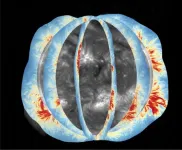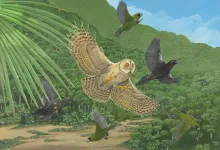(Press-News.org) EMBARGOED: Not for Release Until 2:00 pm U.S. Eastern Time Thursday, 3 October 2024.
A new era of solar observation
International team produces global maps of coronal magnetic field
Contacts:
Audrey Merket, NSF NCAR and UCAR Science Writer and Public Information Officer
amerket@ucar.edu
303-497-8293
David Hosansky, NSF NCAR and UCAR Manager of Media Relations
hosansky@ucar.edu
720-470-2073
For the first time, scientists have taken near-daily measurements of the Sun’s global coronal magnetic field, a region of the Sun that has only been observed irregularly in the past. The resulting observations are providing valuable insights into the processes that drive the intense solar storms that impact fundamental technologies, and thus lives and livelihoods, here on Earth.
An analysis of the data, collected over eight months by an instrument called the Upgraded Coronal Multi-channel Polarimeter (UCoMP), is published today in Science.
The solar magnetic field is the primary driver of solar storms, which can pose threats to power grids, communication systems, and in-space technologies like GPS. However, our ability to understand how the magnetic field builds up energy and erupts has been limited by the challenge of observing it in the solar corona, the Sun’s upper atmosphere.
Measuring the magnetism of the region through standard polarimetric methods typically requires large, expensive equipment that to date has only been able to study small segments of the corona. However, the combined use of coronal seismology and UCoMP observations makes it possible for researchers to produce consistent and comprehensive views of the magnetic field of the global corona — the whole-Sun view one sees during a solar eclipse.
“Global mapping of the coronal magnetic field has been a big missing part in the study of the Sun,” said Zihao Yang, lead author who pursued this research as a PhD graduate at Peking University, China, and is now a postdoctoral fellow at the U.S. National Science Foundation National Center for Atmospheric Research (NSF NCAR). “This research is helping us fill a crucial gap in our understanding of coronal magnetic fields, which are the source of the energy for storms that can impact Earth.”
The international team is made of researchers from Northumbria University, UK; NSF NCAR; Peking University, China; and University of Michigan. The research was funded by a grant from the National Natural Science Foundation of China and the National Key R&D Program of China and supported by the Newkirk graduate student fellowship awarded to Yang by NSF NCAR. The UCoMP instrument was developed with support from the U.S. National Science Foundation (NSF) and is operated by NSF NCAR at the Mauna Loa Solar Observatory.
Upgraded instrument
Although scientists have been able to routinely measure the magnetic field on the Sun’s surface, known as the photosphere, it has long been difficult to measure the much dimmer coronal magnetic field. This has limited a deeper understanding of the three-dimensional structure and evolution of the magnetic field of the corona, where solar storms brew.
To measure the three-dimensional coronal magnetic fields in depth, big telescopes like NSF’s Daniel K. Inouye Solar Telescope (DKIST) are needed. With a 4-meter-diameter aperture, DKIST is the world’s largest solar telescope, and recently demonstrated its groundbreaking ability for making detailed observations of the coronal magnetic field. However, DKIST is not able to map the Sun all at once. The smaller UCoMP instrument is actually better-suited to give scientists global pictures of the coronal magnetic field, albeit at lower resolution and in a two-dimensional projection. The observations from both sources are thus highly-complementary to a holistic view of the coronal magnetic field.
UCoMP is primarily a coronagraph, an instrument that uses a disc to block out light from the Sun, similar to an eclipse, making it easier to observe the corona. It also combines a Stokes polarimeter, which images other spectral information such as coronal line intensity and Doppler velocity. Even though UCoMP has a much smaller aperture (20 cm), it is able to take a wider view which makes it possible to study the entire Sun on most days.
The researchers applied a method called coronal seismology to track magnetohydrodynamic (MHD) transverse waves in the UCoMP data. The MHD waves gave them information that made it possible to create a two-dimensional map of the strength and direction of the coronal magnetic field.
In 2020, a previous study used UCoMP’s predecessor and the coronal seismology method to produce the first map of the global coronal magnetic field. This was a crucial step toward routine coronal magnetic field measurements. UCoMP has expanded capabilities that makes it possible to make more detailed, routine measurements. During the UCoMP study, the research team produced 114 magnetic field maps between February and October 2022, or one almost every other day.
“We are entering a new era of solar physics research where we can routinely measure the coronal magnetic field,” said Yang.
Completing the picture
The observations also produced the first measurements of the coronal magnetic field in the polar regions. The Sun’s poles have never been directly observed because the curve of the Sun near the poles keeps it just beyond our view from Earth. Though the researchers didn’t directly view the poles, for the first time they were able to take measurements of the magnetism emitting from them. This was due in part to the improved data quality provided by UCoMP and because the Sun was near solar maximum. The typically weak emissions from the polar region have been much stronger, making it easier to obtain coronal magnetic field results in the polar regions.
As a postdoctoral fellow at NSF NCAR, Yang will continue his research of the Sun’s magnetic field; he hopes to improve existing coronal models that are based on measurements of the photosphere. Since the current method used with UCoMP is limited to two dimensions, it still doesn’t capture the full three-dimensional magnetic field. Yang and his colleagues hope to combine their research with other techniques to get a deeper understanding of the full vector of the magnetic field in the corona.
The third dimension of the magnetic field, oriented along a viewer's line of sight, is of particular importance for understanding how the corona is energized leading up to a solar eruption. Ultimately, a combination of a large telescope and a global field of view is needed to measure all the three-dimensional twists and tangles behind phenomena like solar eruptions; this is the motivation behind the proposed Coronal Solar Magnetism Observatory (COSMO), a 1.5-meter-diameter solar refracting telescope undergoing its final design study.
“Since coronal magnetism is the force that sends mass from the Sun flying across the solar system, we have to observe it in 3D — and everywhere all at once, throughout the global corona,” said Sarah Gibson, COSMO Development Lead and an NSF NCAR scientist co-author on the paper. "Yang's work represents a huge step forward in our ability to understand how the Sun's global coronal magnetic field changes from day to day. This is critical to our ability to better predict and prepare for solar storms, which are an ever-increasing danger to our ever-more technologically dependent lives here on Earth."
About the article:
Title: Observing the evolution of the Sun’s global coronal magnetic field over eight months
Authors: Zihao Yang, Hui Tian, Steven Tomczyk, Xianyu Liu, Sarah Gibson, Richard J. Morton, and Cooper Downs
Journal: Science
This material is based upon work supported by the NSF National Center for Atmospheric Research, a major facility sponsored by the U.S. National Science Foundation and managed by the University Corporation for Atmospheric Research. Any opinions, findings and conclusions or recommendations expressed in this material do not necessarily reflect the views of NSF.
END
A new era of solar observation
International team produces global maps of coronal magnetic field
2024-10-03
ELSE PRESS RELEASES FROM THIS DATE:
The true global impact of species-loss caused by humans is far greater than expected – new study reveals
2024-10-03
The extinction of hundreds of bird species caused by humans over the last 130,000 years has has led to substantial reductions in avian functional diversity – a measure of the range of different roles and functions that birds undertake within the environment –
and resulted in the loss of approximately 3 billion years of unique evolutionary history, according to a new study published today in Science.
Whilst humans have been driving a global erosion of species richness for millennia, the consequences of past extinctions for other dimensions of biodiversity are poorly known. ...
Smartphone-assisted “scavenger hunt” identifies people at risk for dementia
2024-10-03
Researchers from DZNE and Otto von Guericke University Magdeburg have identified individuals with increased risk for dementia using mobility data, recorded during a smartphone-based wayfinding task on the university campus. The findings, reported in the journal PLOS Digital Health, show the potential of smartphone data, collected in conditions close to everyday life, for the early detection and monitoring of Alzheimer’s disease. The study included 72 adults; about a third of them with subjective cognitive decline (SCD), a condition that is a known risk factor for dementia.
Alzheimer’s disease usually develops unnoticed over years and eventually ...
Green subsidies may have hidden costs, experts warn
2024-10-03
Government subsidies for business practices and processes should be approached with caution, even when they seem to be environmentally friendly, writes a group of scientists and economists in this week’s Policy Forum in the journal Science.
They argue that subsidies can alter market pressures, leading to unintended consequences that not only perpetuate harmful subsidies over time but also diminish the overall effectiveness of those intended to promote environmental sustainability.
Therefore, when they must be used, subsidies should have clear end-dates, advise the authors.
“We’ve got this odd juxtaposition of ...
Small brains can accomplish big things, according to new theoretical research
2024-10-03
Neuroscientists had a problem.
For decades, researchers had a theory about how an animal’s brain keeps track of where it is relative to its surroundings without outside cues – like how we know where we are, even with our eyes closed.
According to the theory, which was based on brain recordings from rodents, networks of neurons called ring attractor networks maintain an internal compass that keeps track of where you are in the world. An accurate internal compass was thought to require a large network with many neurons, while a small network with few neurons would cause the compass’s needle to drift, creating errors.
Then researchers discovered an internal compass ...
UTA professor honored for science education leadership
2024-10-03
University of Texas at Arlington UTeach Master Teacher Karen Jo Matsler will be awarded the 2025 Melba Newell Phillips Medal in January from the American Association of Physics Teachers (AAPT) in recognition of her extensive contributions to physics education and her tireless efforts to support educators nationwide. Founded in 1930, AAPT is a national organization dedicated to advancing the teaching and understanding of physics.
For more than 20 years, Dr. Matsler has been a tireless advocate of physics education, working with state legislators and educational agencies ...
Decline of mpox antibody responses after modified vaccinia Ankara–Bavarian Nordic vaccination
2024-10-03
About The Study: The modified vaccinia Ankara–Bavarian Nordic (MVA-BN) vaccination generated mpox antibodies that waned by 6 to 12 months. In participants who received 2 doses of MVA-BN vaccine, mpox antibody responses at 12 months were comparable to or lower than peak antibody responses in people receiving 1 dose, which provided limited protection.
Quote from corresponding author Dan H. Barouch, MD, PhD:
“In this observational study, we show that mpox antibody responses decline 6-12 months following Jynneos (MVA-BN) vaccination. Our data suggest that protective immunity may ...
Wider use of convalescent plasma might have saved thousands more lives during pandemic
2024-10-03
A new study led by researchers at Johns Hopkins Bloomberg School of Public Health estimates that thousands of lives could have been saved during the first year of the COVID-19 pandemic if convalescent plasma had been used more broadly, particularly in outpatients at high risk for severe disease and in hospitalized patients during their first few days of admission.
Convalescent plasma from patients who had recovered from COVID was used starting in the early months of the pandemic at the urging of a group of physicians who cited the blood ...
Strong coupling between Andreev qubits mediated by a microwave resonator
2024-10-03
Quantum communication and quantum computing operate based on quantum bits (qubits) as the smallest unit of information — related to bits in a classical computer. Of the many different approaches currently being investigated around the world, one promising option is to use Andreev pair qubits.
These qubits are formed at interfaces between a metal and a superconductor in a process known as Andreev reflection. Here, an electron from the metal enters the superconductor, where it becomes part of an electron pair (a Cooper pair) — while a hole, ...
UNF biological sciences professor receives NIH grant to study muscle atrophy
2024-10-03
Jacksonville, Fla. – A University of North Florida biology professor has been awarded a prestigious four-year National Institutes of Health (NIH) grant totaling over $720K to study the functional role of an enzyme called dual-specificity phosphatase 4 (Dusp4) in skeletal muscle atrophy.
Dr. David Waddell’s NIH-funded research project will help contribute to knowledge about skeletal muscle atrophy associated with neuromuscular disorders, neurodegenerative diseases and aging. Skeletal muscle atrophy is a decrease in muscle mass that occurs when protein degradation exceeds protein ...
Child Health Day 2024: influenza vaccine protects children from infection and hospitalization for the disease, Spanish study shows
2024-10-03
A study published on Eurosurveillance has demonstrated that Spain's influenza vaccination campaign for children aged 6-59 months during the 2023/24 season was effective in preventing acute respiratory infections (ARI) and hospitalisation, as vaccination was recommended for this age group at the national level for the first time.
In the context of Child Health Day 2024, this research emphasises that continued efforts should be made to increase vaccination coverage among children for future seasons.
Context and methods
Influenza A was dominant in the 2023/2024 season, ...
LAST 30 PRESS RELEASES:
Tracing the quick synthesis of an industrially important catalyst
New software sheds light on cancer’s hidden genetic networks
UT Health San Antonio awarded $3 million in CPRIT grants to bolster cancer research and prevention efforts in South Texas
Third symposium spotlights global challenge of new contaminants in China’s fight against pollution
From straw to soil harmony: International team reveals how biochar supercharges carbon-smart farming
Myeloma: How AI is redrawing the map of cancer care
Manhattan E. Charurat, Ph.D., MHS invested as the Homer and Martha Gudelsky Distinguished Professor in Medicine at the University of Maryland School of Medicine
Insilico Medicine’s Pharma.AI Q4 Winter Launch Recap: Revolutionizing drug discovery with cutting-edge AI innovations, accelerating the path to pharmaceutical superintelligence
Nanoplastics have diet-dependent impacts on digestive system health
Brain neuron death occurs throughout life and increases with age, a natural human protein drug may halt neuron death in Alzheimer’s disease
SPIE and CLP announce the recipients of the 2025 Advanced Photonics Young Innovator Award
Lessons from the Caldor Fire’s Christmas Valley ‘Miracle’
Ant societies rose by trading individual protection for collective power
Research reveals how ancient viral DNA shapes early embryonic development
A molecular gatekeeper that controls protein synthesis
New ‘cloaking device’ concept to shield sensitive tech from magnetic fields
Researchers show impact of mountain building and climate change on alpine biodiversity
Study models the transition from Neanderthals to modern humans in Europe
University of Phoenix College of Doctoral Studies releases white paper on AI-driven skilling to reduce burnout and restore worker autonomy
AIs fail at the game of visual “telephone”
The levers for a sustainable food system
Potential changes in US homelessness by ending federal support for housing first programs
Vulnerability of large language models to prompt injection when providing medical advice
Researchers develop new system for high-energy-density, long-life, multi-electron transfer bromine-based flow batteries
Ending federal support for housing first programs could increase U.S. homelessness by 5% in one year, new JAMA study finds
New research uncovers molecular ‘safety switch’ shielding cancers from immune attack
Bacteria resisting viral infection can still sink carbon to ocean floor
Younger biological age may increase depression risk in older women during COVID-19
Bharat Innovates 2026 National Basecamp Showcases India’s Most Promising Deep-Tech Ventures
Here’s what determines whether your income level rises or falls
[Press-News.org] A new era of solar observationInternational team produces global maps of coronal magnetic field



